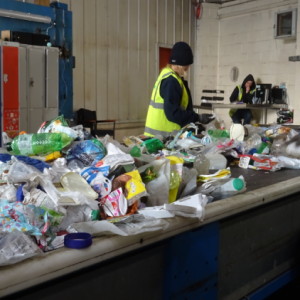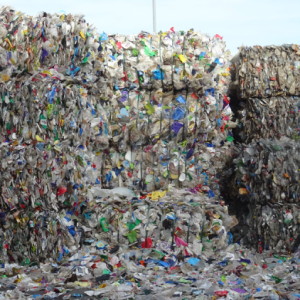PRF
A fascinating tour of the Plastics Recovery Facility today and lots to tell. There are many facilities dotted all over the country which sort mixed recyclables into their separate groups, which are then transferred to more specialised sorting facilities. So a Materials Recovery Facility will separate plastic, paper, metal and glass and then dispatch those to the specialist centres. But even so, a certain amount of paper, glass and metal arrives at the specialised Plastics facility. So first job is to have another go at separating out what the plastics plant is not interested in.
Glass is fantastically abrasive and really damages the machinery so it's important to get rid of that as soon as possible. Aluminium cans are extremely valuable so we aren't going to chuck those out with the bath water if it can be avoided, and paper, well, it isn't plastic and so we cannot sell it to our plastic-purchasing customers, so that too must be separated out.
Once we have got down to a variety of different types of plastic, that is then divided into SEVEN different types. I was amazed! It is divided by type and also colour and we have an assortment of different methods for sorting it all out.
There are magnets which get the ferrous metals off the line and an eddy to get the non-ferrous metals out. The eddy works by pushing opposing magnets close together apparently, not too sure I understand that one properly. There is also ballistic separation which is paddles on an incline and some fantastic rule of physics means that flat things journey upwards and round things like bottles roll down. But the really magnificent piece of kit is the optical separator. It uses an infra-red beam to determine what type of plastic and item on the belt is made of and then fires a jet of air at it to knock it onto the correct side of the belt. We have a shed-full of these beasties, in series, perfecting the assessment of the ones upstream.
We also have a small quantity of People Wearing Gloves who are trained and skilled enough to assess a whole mixed pile of stuff into ten separate bins which of course are for paper, metal, glass and seven separate classifications of plastic. The role of the People Wearing Gloves is to compare the output from the machines, which is doing a better job? Do the machines need to be adjusted? The machines are fabulously expensive but pay their way because they are run non-stop around the clock and they are always run to maximum capacity.
And this was why the plant was clean and silent today, not enough throughput had arrived to justify running it, but that meant that we could hear what we were being told and it wasn't as scary as it could have been with 140 conveyor belts all running in every imaginable direction.
Another thing I learned is that old video tape is a nightmare. The cases get broken and miles of tape wraps itself around the belt rollers and other items to be separated, meaning that they don't get separated as they should.
And lithium batteries. Nightmare! The cause of the majority of fires. Apparently the last fire at this facility in 2015 could be seen from Tower Bridge.
Once the plastics have been separated by type and colour they are then sold to people who want to re-use them, mostly Chinese manufacturers. As our tastes have tended towards improved quality products, Chinese manufacturers have learned that they cannot make their products from any old rubbish, and so the quality of our output has had to rise to meet these new standards. And the people hand-sorting on the line? Mostly Polish. Most British people would turn their noses up at this kind of work. So Hurrah for Brexit and all the exciting employment opportunities it will bring once we have kicked out of the country the handful of people who are actually prepared to clean up after us.



Comments
Sign in or get an account to comment.


